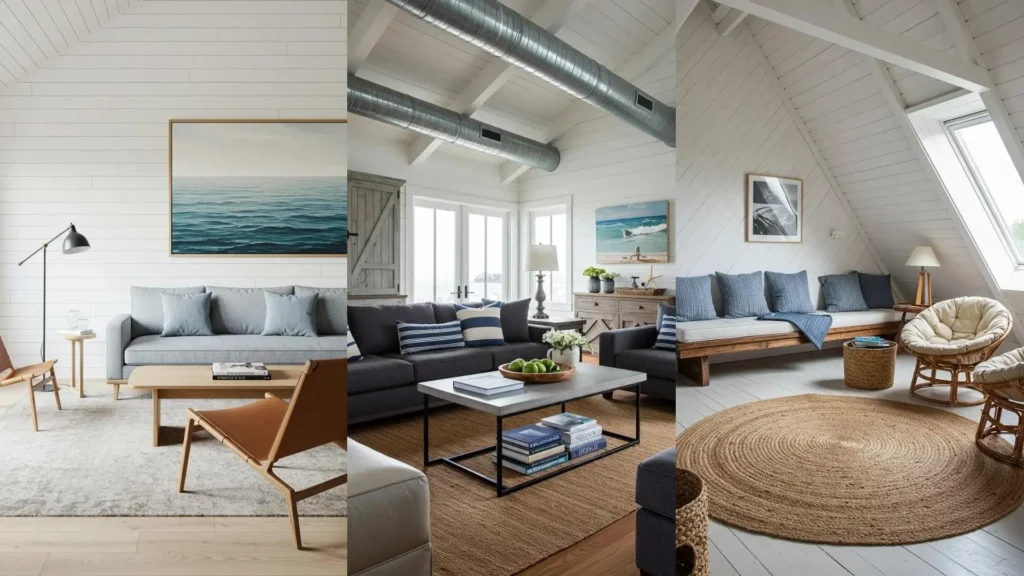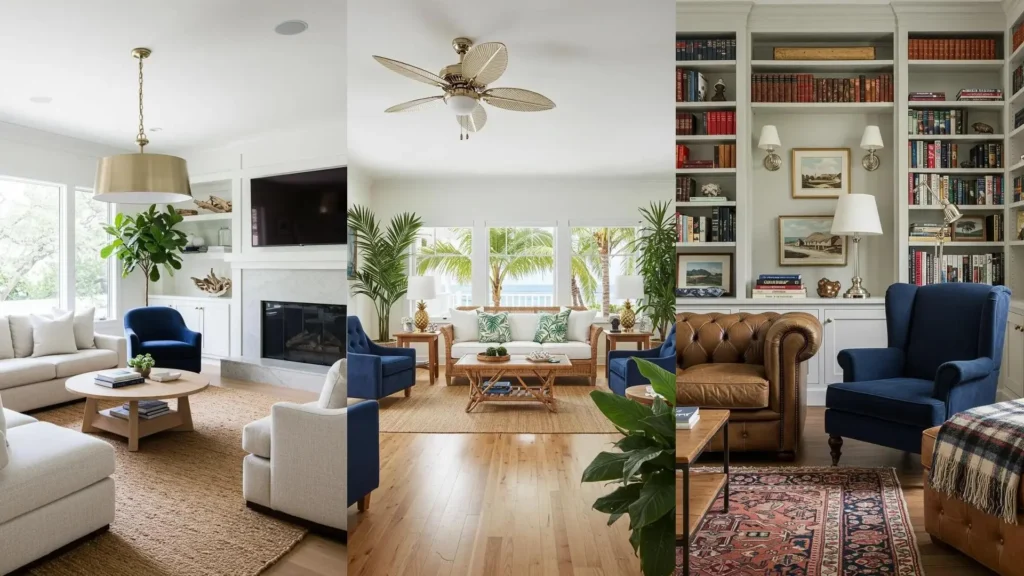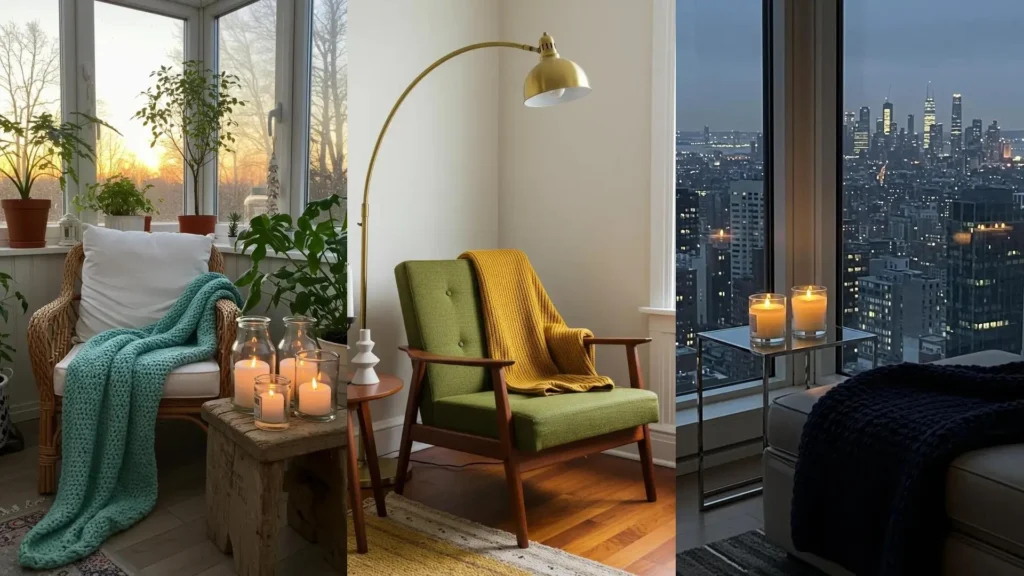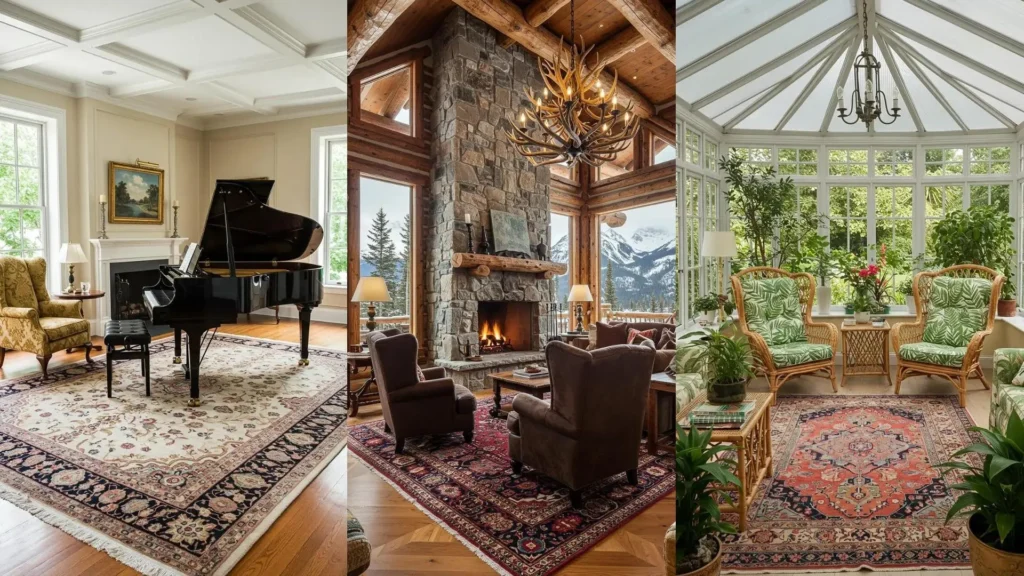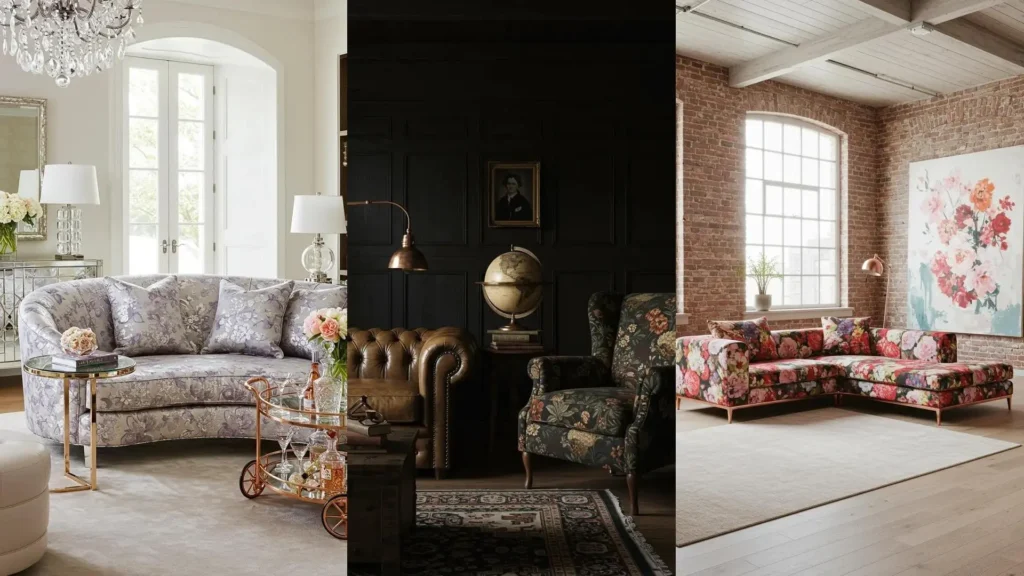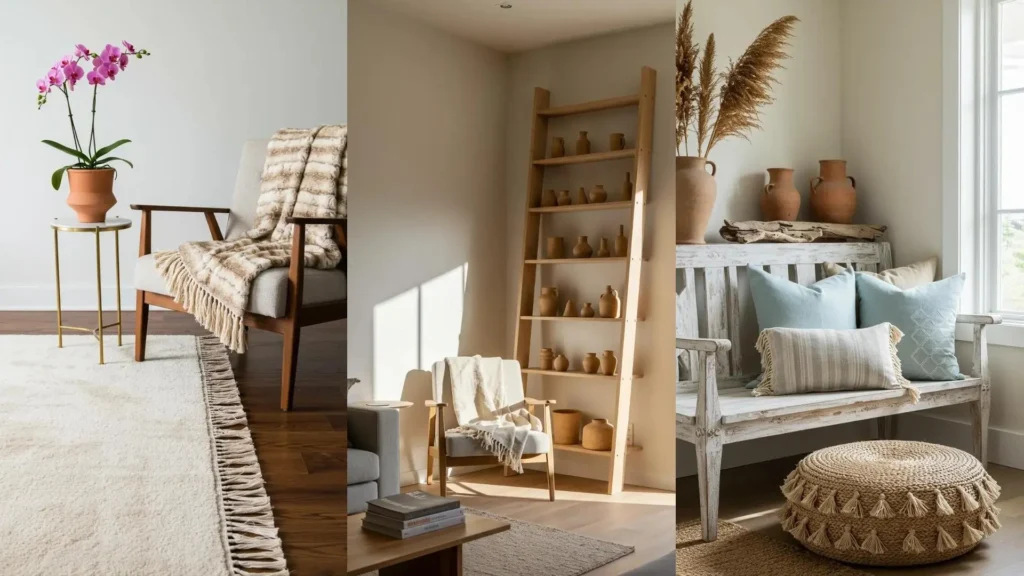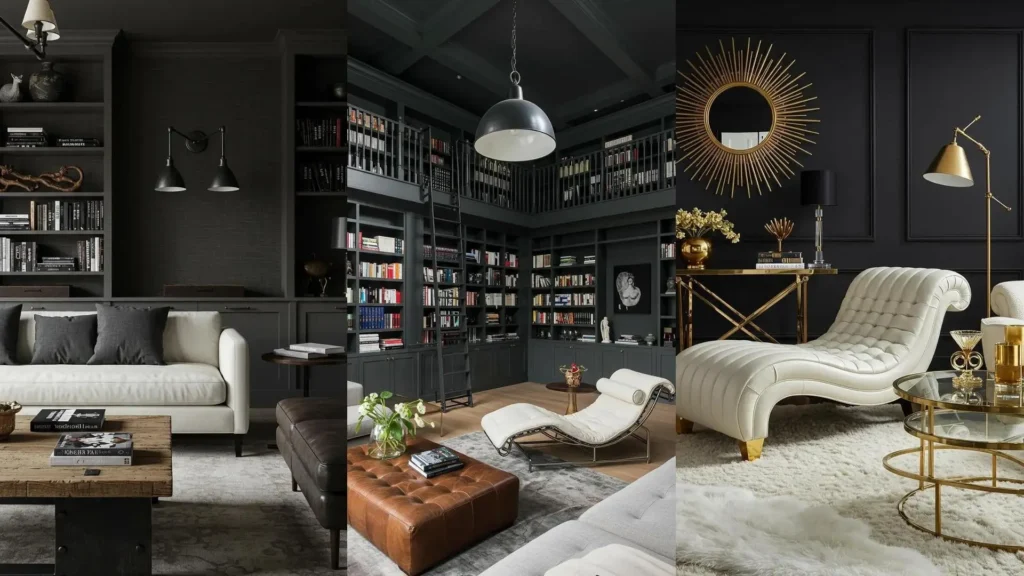The enduring appeal of the coastal farmhouse style lies in its balance. It is both rustic and refined, relaxed and elegant, filled with light yet grounded by texture. It’s a style that feels like a deep, calming breath.
Achieving this look isn’t about a rigid set of rules, but about understanding how the core elements—whitewashed shiplap, natural fibers, weathered woods, and a palette of blues and sands—work in harmony. Each choice should contribute to a feeling of ease and effortless grace.
In the ideas that follow, I’ll guide you through specific, actionable ways to bring this serene aesthetic into your own living room. These are not grand renovations, but thoughtful adjustments that will help you create a space that feels personal, cohesive, and deeply restorative.
1. Ground Your Space with Natural Textures
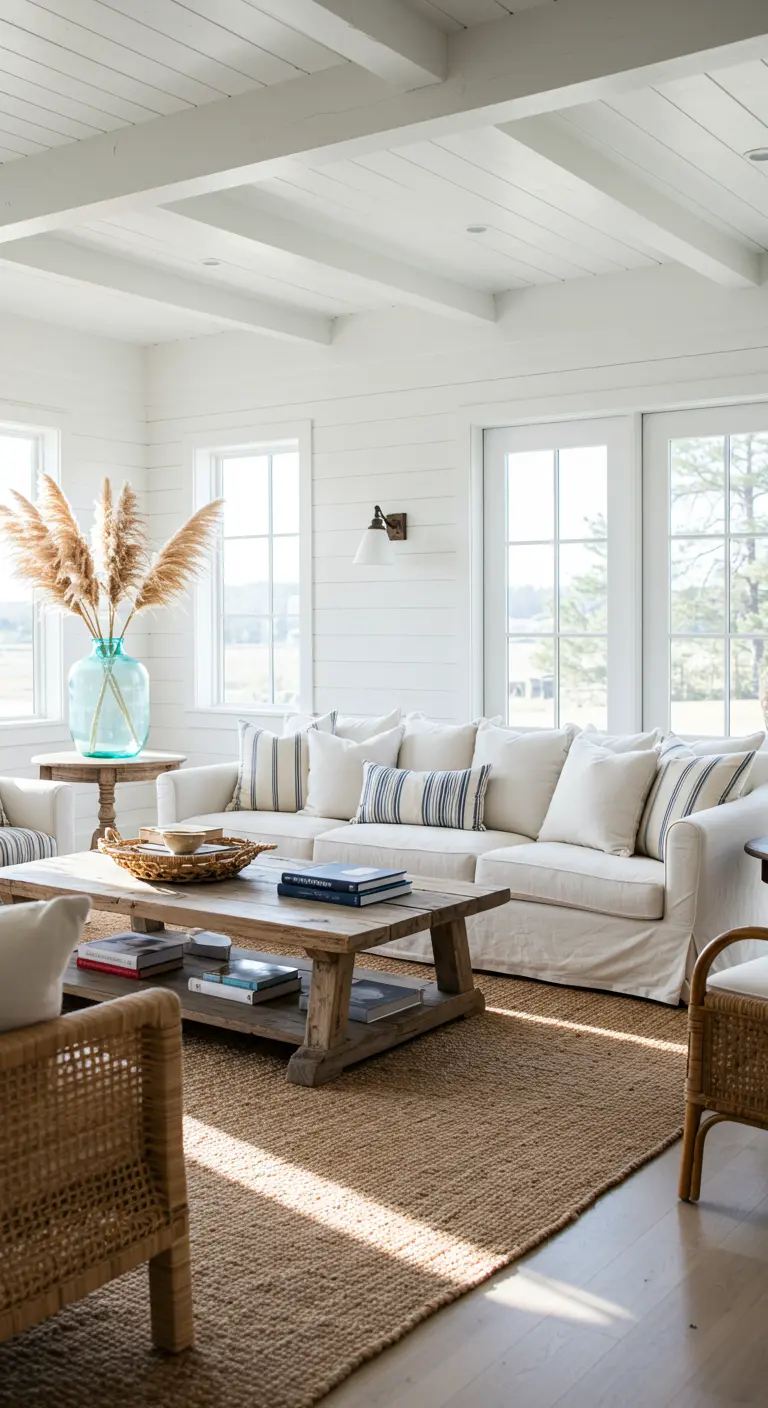
Begin with a foundational layer of natural texture to warm up crisp, whitewashed shiplap.
A large jute or sisal rug defines the seating area and provides an earthy, organic base that feels wonderful underfoot.
Choose a relaxed, slipcovered sectional. This not only offers a comfortable, inviting silhouette but is also incredibly practical for everyday life.
Finally, introduce classic blue and white striped cushions. They provide that quintessential coastal touch without overpowering the serene, neutral backdrop.
2. Integrate Stone for Earthy Warmth
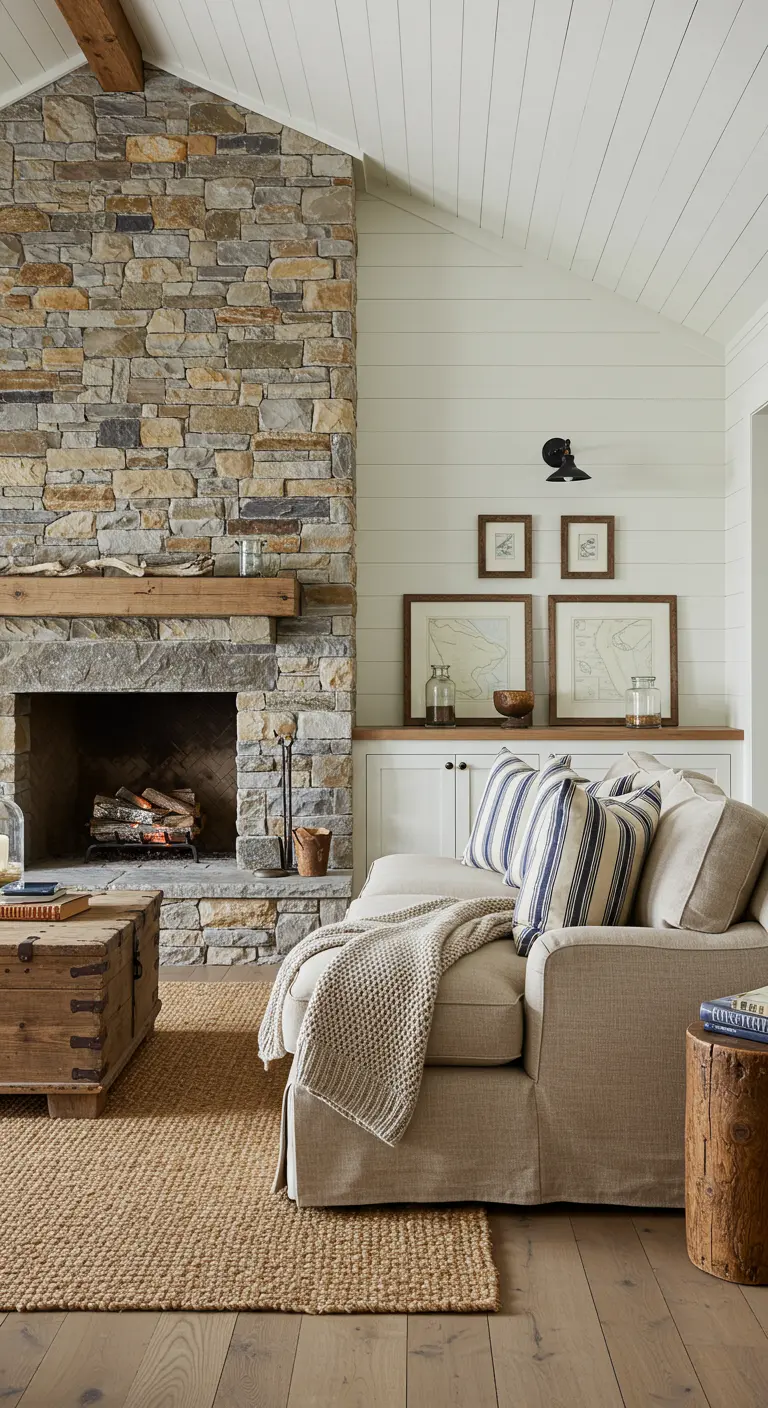
If you have a fireplace, let it be a statement of natural, rugged texture.
A floor-to-ceiling fieldstone surround provides a powerful, organic anchor in a room of clean white lines.
Balance the stone’s visual weight with soft, plush furnishings and a warm, chunky knit throw.
A simple, reclaimed wood mantel adds a final rustic touch that connects the stone to the wooden elements elsewhere in the space.
3. Create a Conversational Layout
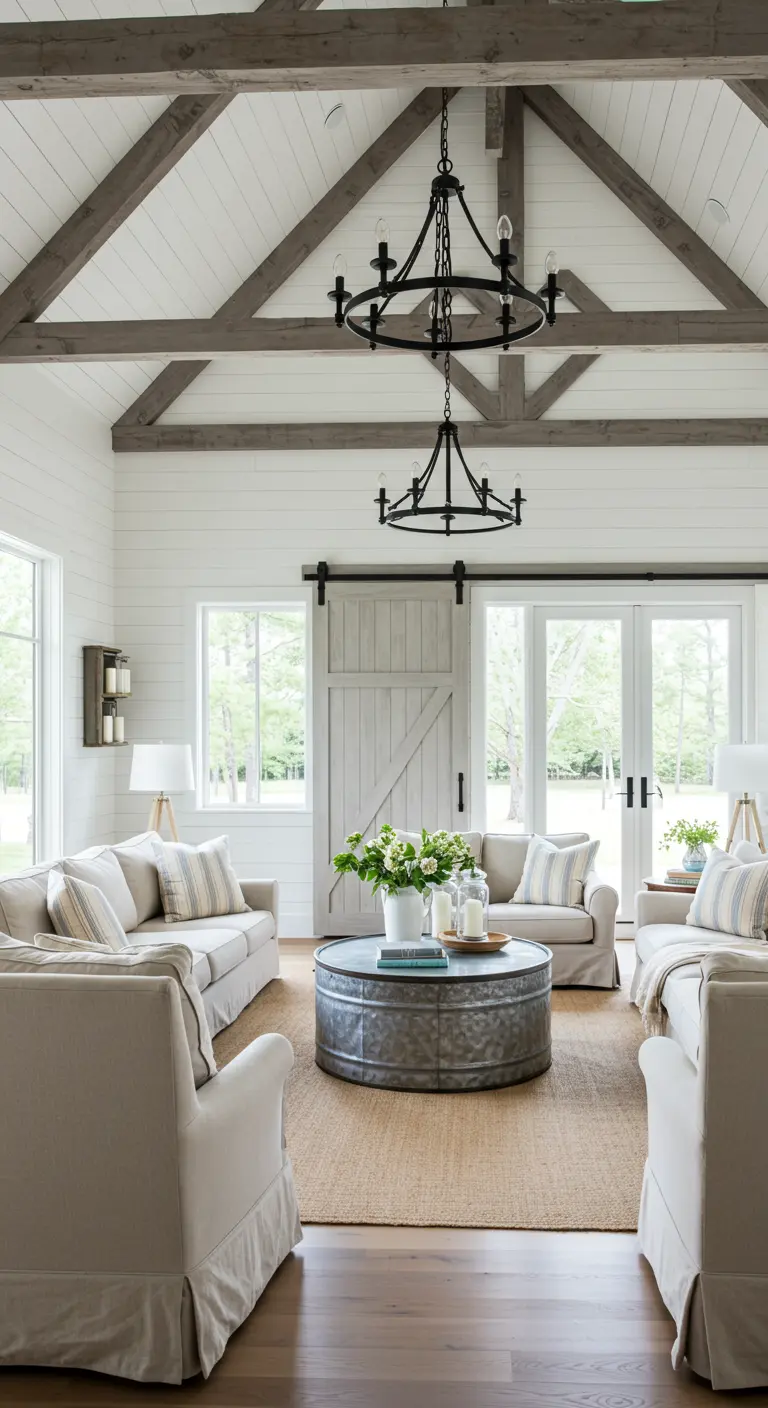
Arrange your furniture to encourage connection, not just to face a screen.
Placing two sofas directly opposite each other, with armchairs to close the loop, creates a natural and welcoming conversation area.
An oversized coffee table in the center anchors the arrangement. Choosing one made from galvanized metal adds a subtle industrial farmhouse element.
A sliding barn door is a brilliant space-saver that also serves as a strong architectural feature, reinforcing the farmhouse aesthetic.
4. Design a Purposeful Window Nook

Transform a bright corner into more than just empty space by building in a window seat.
This creates a destination—a perfect spot for reading or enjoying a morning coffee with a view.
Incorporate deep drawers below the seat for discreet and highly practical storage. This helps keep your main living area uncluttered.
Use a durable, solid blue fabric for the main cushion, then layer in personality with classic striped pillows, making it one of those cozy corners you’ll gravitate towards daily.
5. Soften Light with Sheer Curtains
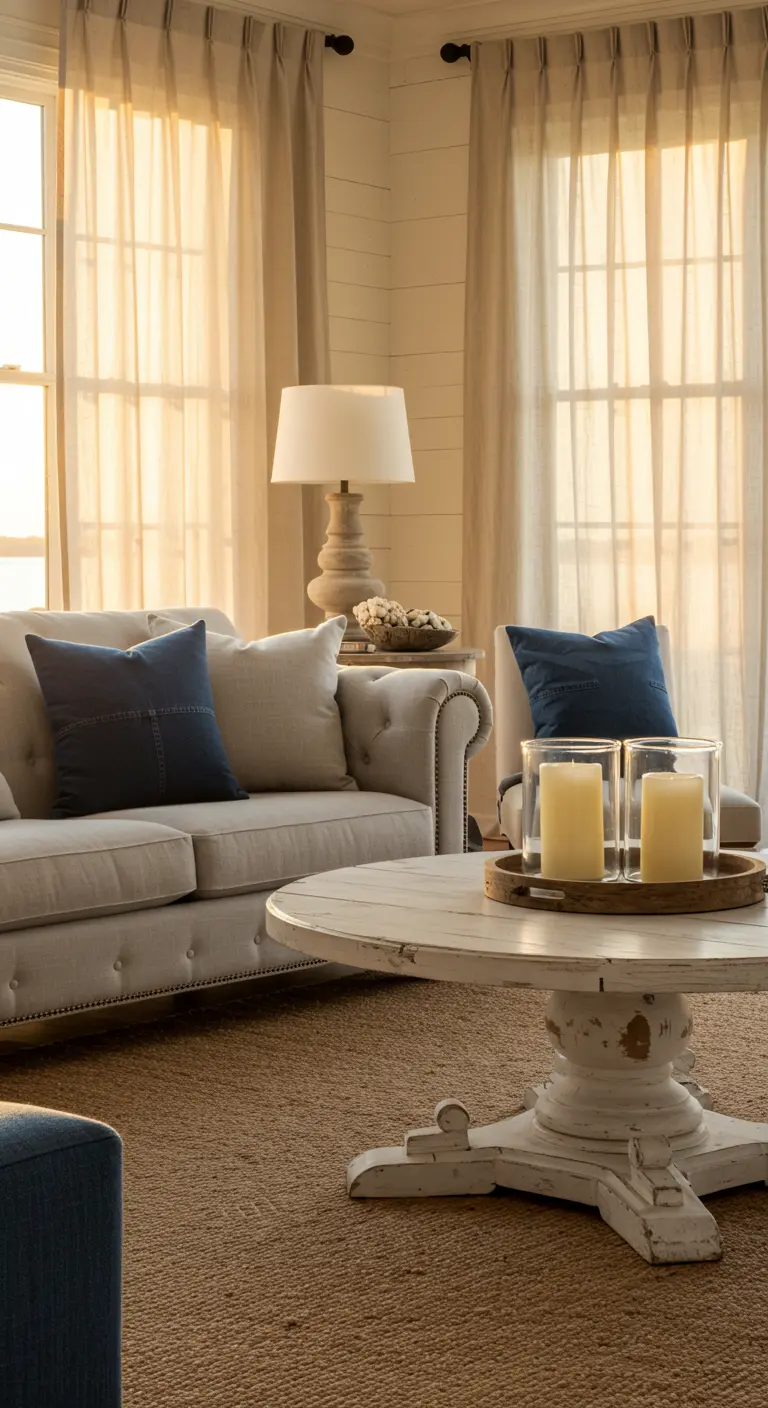
To achieve that signature breezy, coastal feel, avoid heavy, opaque drapes.
Opt for simple, floor-length curtains in a sheer linen fabric. They won’t block the light, but rather diffuse it, filling your room with a soft, ethereal glow.
This approach maintains privacy while maximizing the sense of airiness that is so crucial to this style.
A distressed white pedestal coffee table adds a touch of vintage charm that prevents the space from feeling too new or stark.
6. Introduce a Modern Coastal Edge
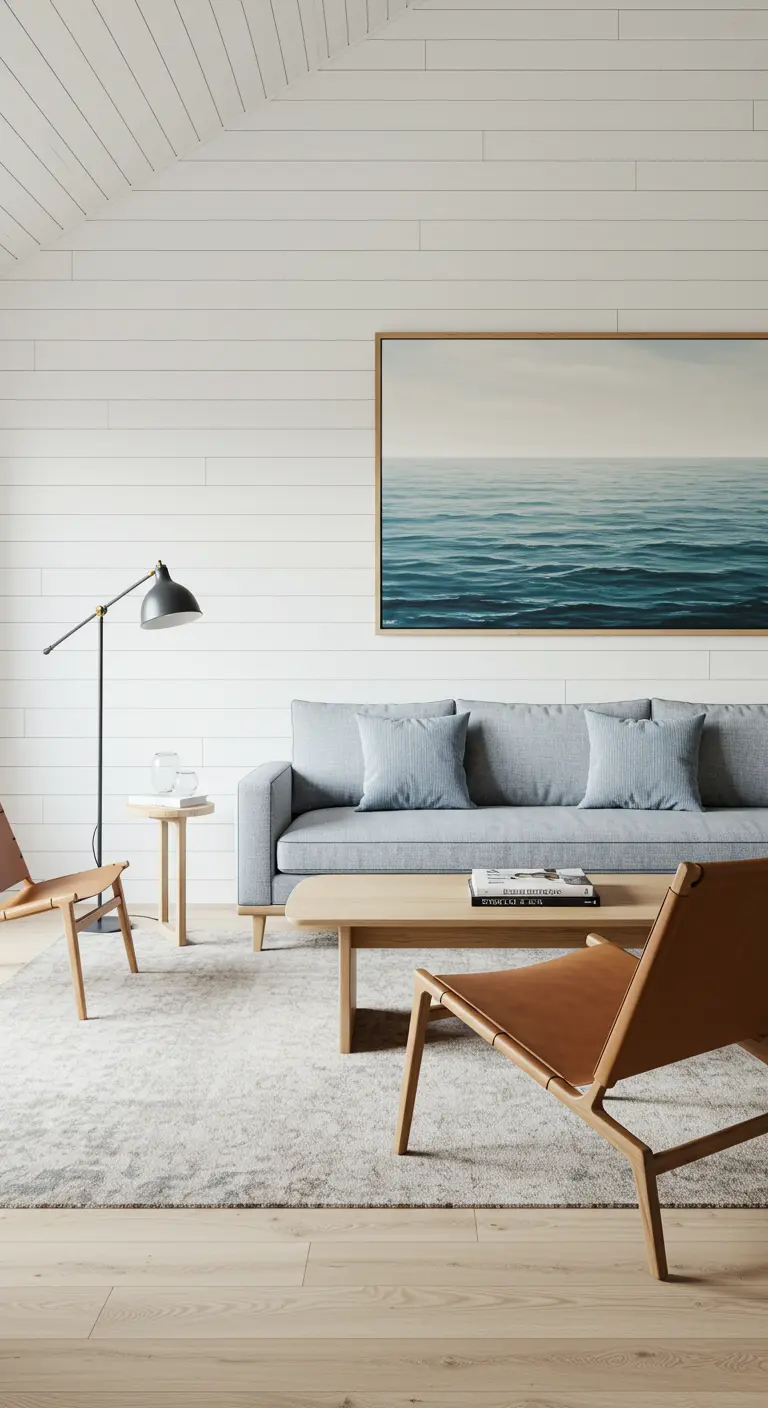
Coastal farmhouse can feel incredibly current by blending it with cleaner, more modern forms.
Instead of a traditional sofa, consider one with a sleeker silhouette and tapered legs. Pair it with iconic leather sling chairs for a touch of mid-century modern polish.
A large, atmospheric seascape painting acts as the primary focal point, reinforcing the coastal theme in a sophisticated, contemporary way.
7. Frame a Nook with Symmetrical Shelving
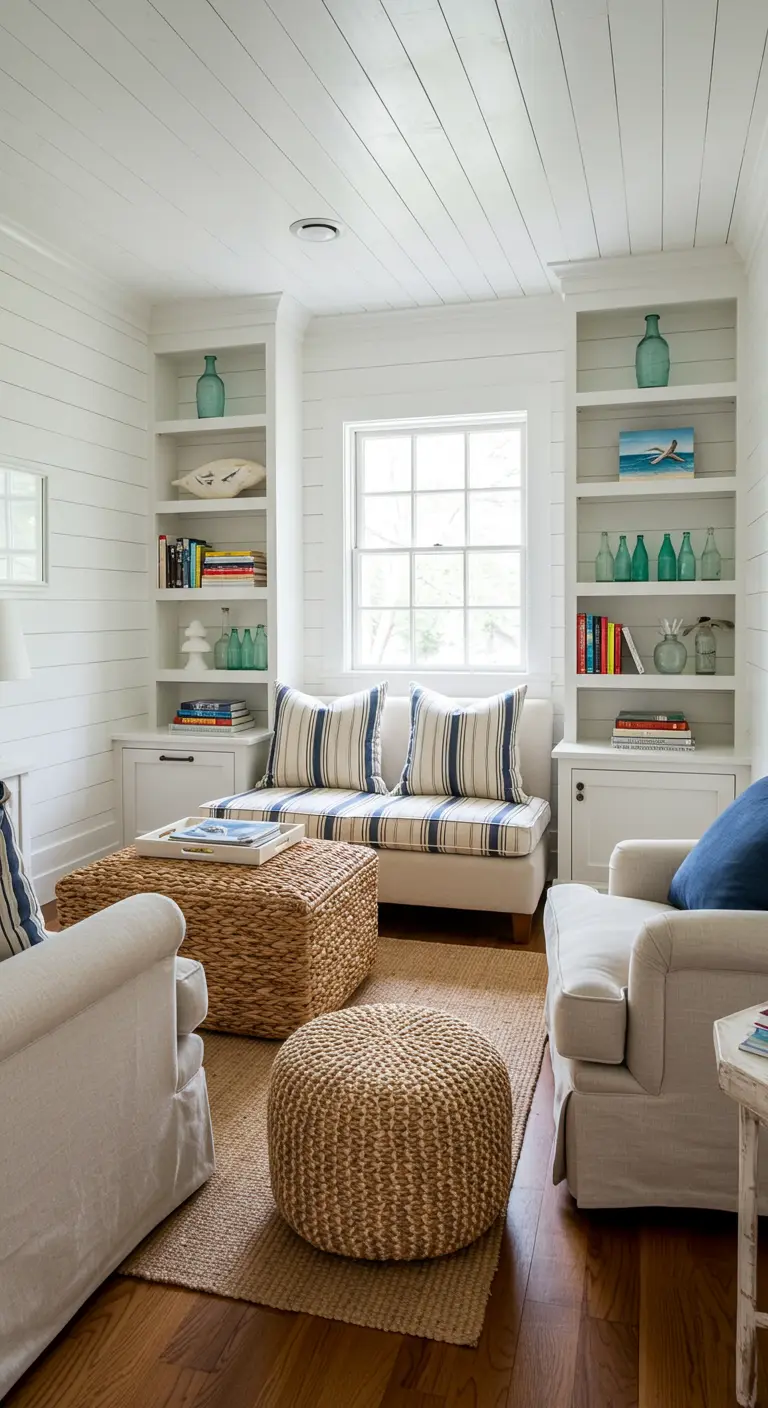
Create an architectural feature and a cozy destination by building bookshelves to flank a settee or window.
Painting the shelves the same crisp white as the shiplap walls gives them a seamless, custom, built-in appearance.
Style them with intention. A mix of curated books and a collection of sea-glass colored vases adds personality and a pop of color that feels authentic to the coastal look.
8. Erase the Line Between Indoors and Out
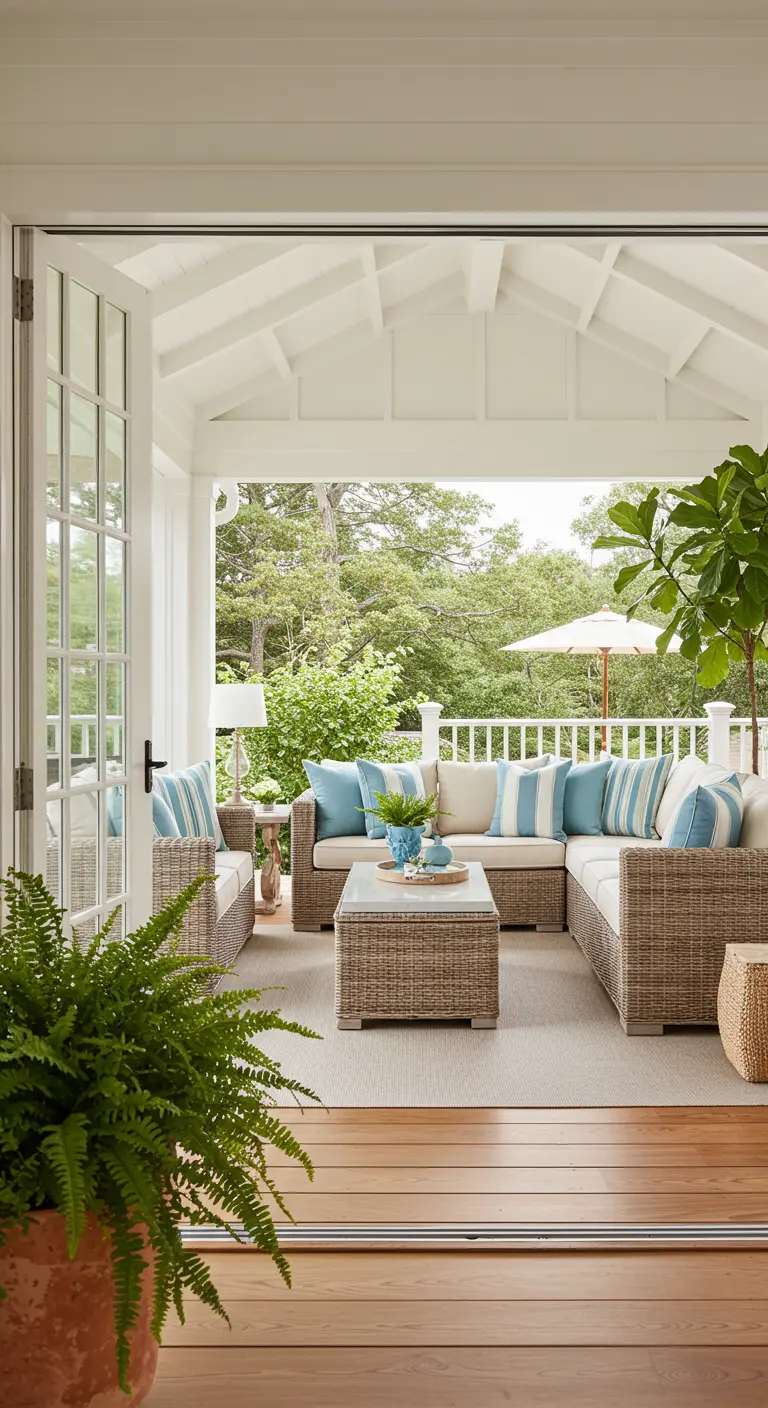
If you have the ability, use wide glass doors to physically and visually connect your living room to a covered porch or patio.
Furnish the outdoor area as you would an indoor one, with a comfortable, weather-resistant woven sectional.
Using the same color palette of blues and whites for the outdoor cushions extends your living space and enhances the breezy, open-air feeling essential to a coastal home.
9. Choose Furniture with a Story

Give your room a sense of history by incorporating pieces that feel collected over time.
A vintage steamer trunk is a brilliant coffee table substitute; it provides hidden storage while adding immense character and a talking point.
A simple wooden daybed feels less formal and more relaxed than a structured sofa. Pair it with rustic lantern-style wall sconces to complete the warm, lived-in aesthetic.
10. Curate Art with a Coastal Narrative
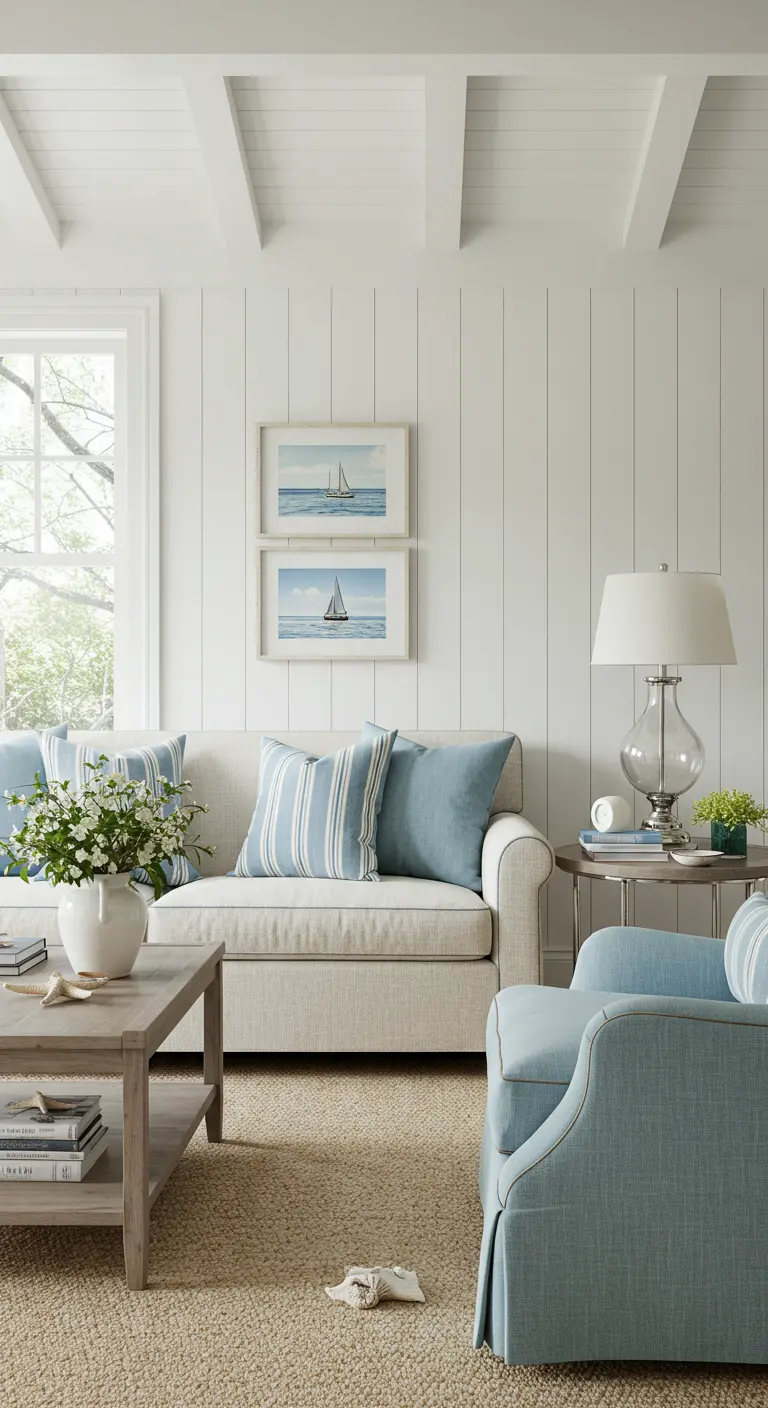
Strengthen your design theme with carefully selected artwork that tells a story.
A simple pair of sailboat paintings in light, natural wood frames feels personal and on-point, avoiding clichéd beach decor.
Complement the art with a lamp that has a clear glass base. It adds to the light, airy aesthetic and subtly echoes the look of sea glass without being too literal.
11. Go Bold with Nautical Elements
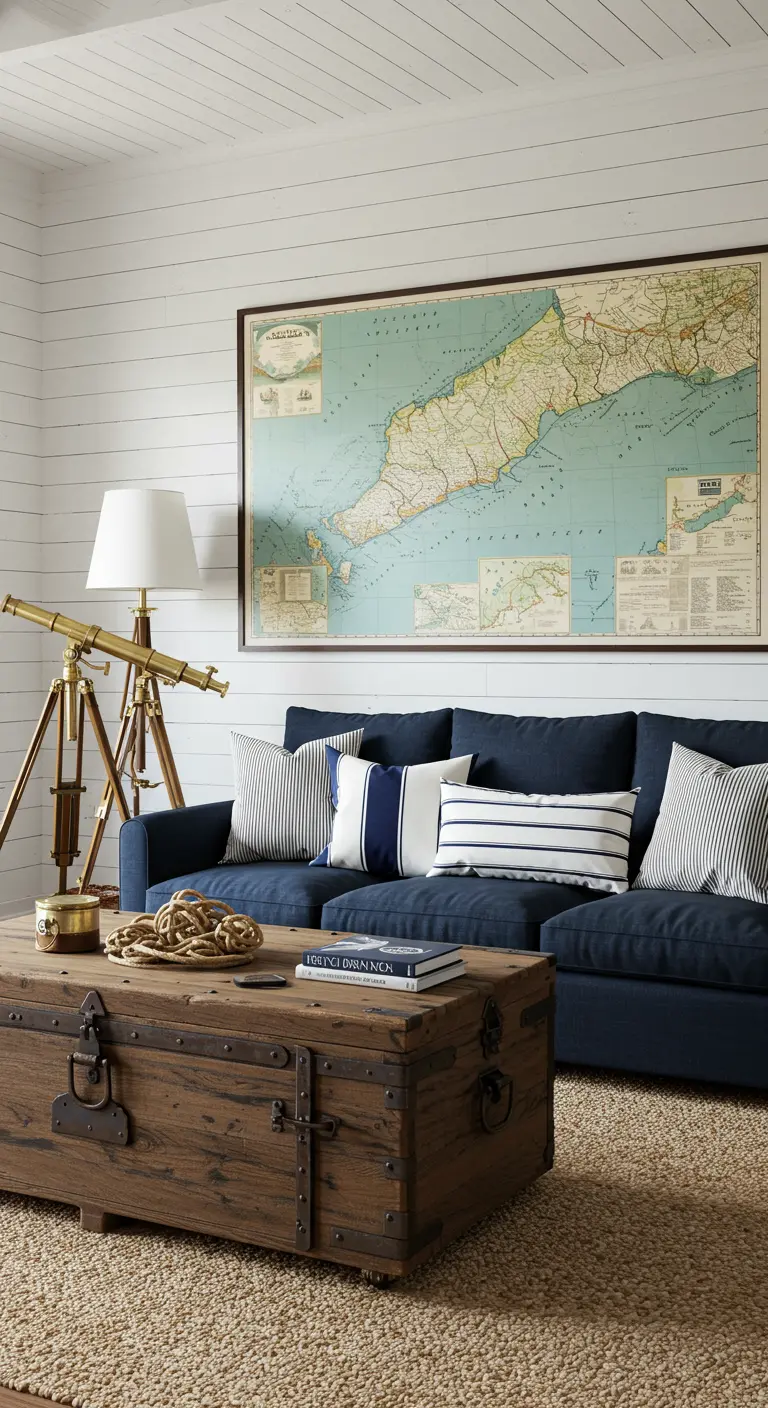
For a more defined and dramatic take on the coastal theme, anchor the room with a deep navy sofa.
Above it, make a significant statement by hanging an oversized vintage nautical map. This instantly becomes the room’s focal point.
Accessorize with polished brass elements, like a tripod telescope, to add a layer of sophisticated, seafaring history.
12. Layer Patterns and Solids with Pillows
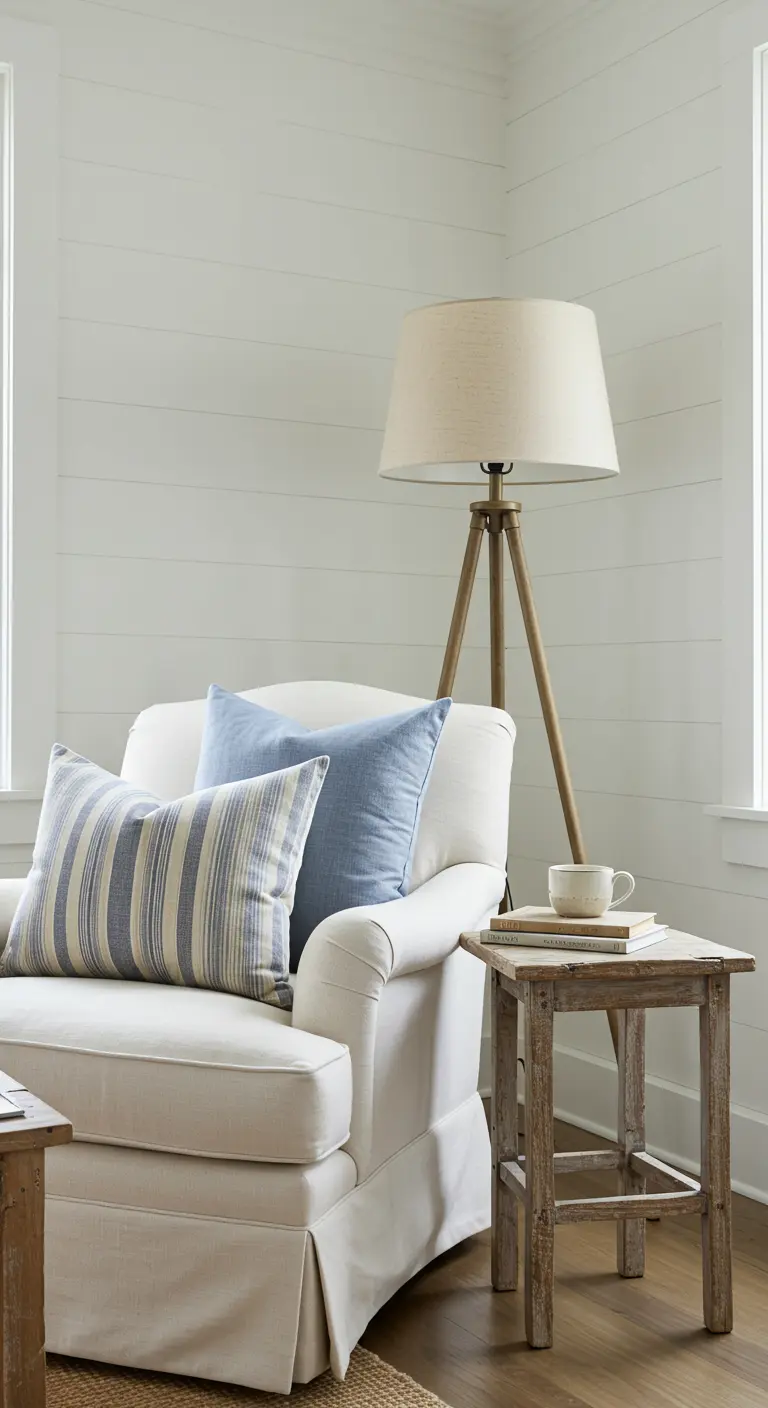
One of the most effective and immediate ways to elevate your space is through textiles.
On a neutral armchair, create a dynamic pairing by layering a classic, bold striped pillow in front of a solid one in a complementary shade of chambray or denim blue.
This simple combination adds visual depth and a polished feel without overwhelming the calm of the room. It’s all about confident, simple choices.
13. Anchor with Symmetry and Central Texture

A symmetrical layout is inherently calming and pleasing to the eye. Here, the fireplace is flanked by identical built-in cabinets and shelving, creating a perfect sense of balance.
In the center of this balanced arrangement, place a large, woven coffee table or trunk. It introduces a strong textural element that grounds the entire room.
This technique works especially well in elegant neutral palettes, where texture becomes paramount.
14. Inject Personality with a Colorful Rug
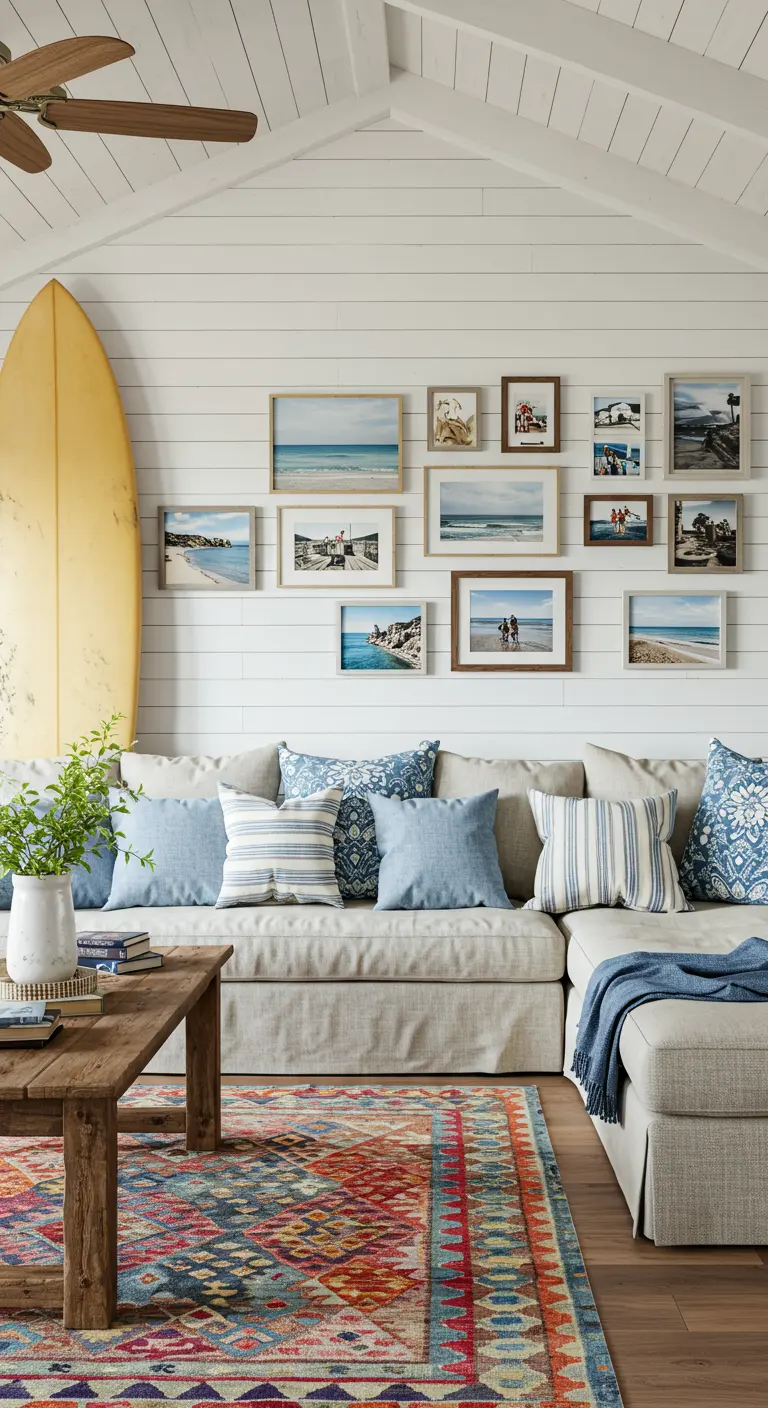
While the coastal farmhouse palette is often neutral, it embraces personality.
Introduce a vibrant, patterned rug to inject energy and a more eclectic, bohemian spirit into the space.
This becomes your anchor piece. Pull accent colors from the rug for your pillows and create a casual gallery wall with personal beach photos to complete a look that feels uniquely yours.
15. Layer Your Lighting for Evening Ambiance
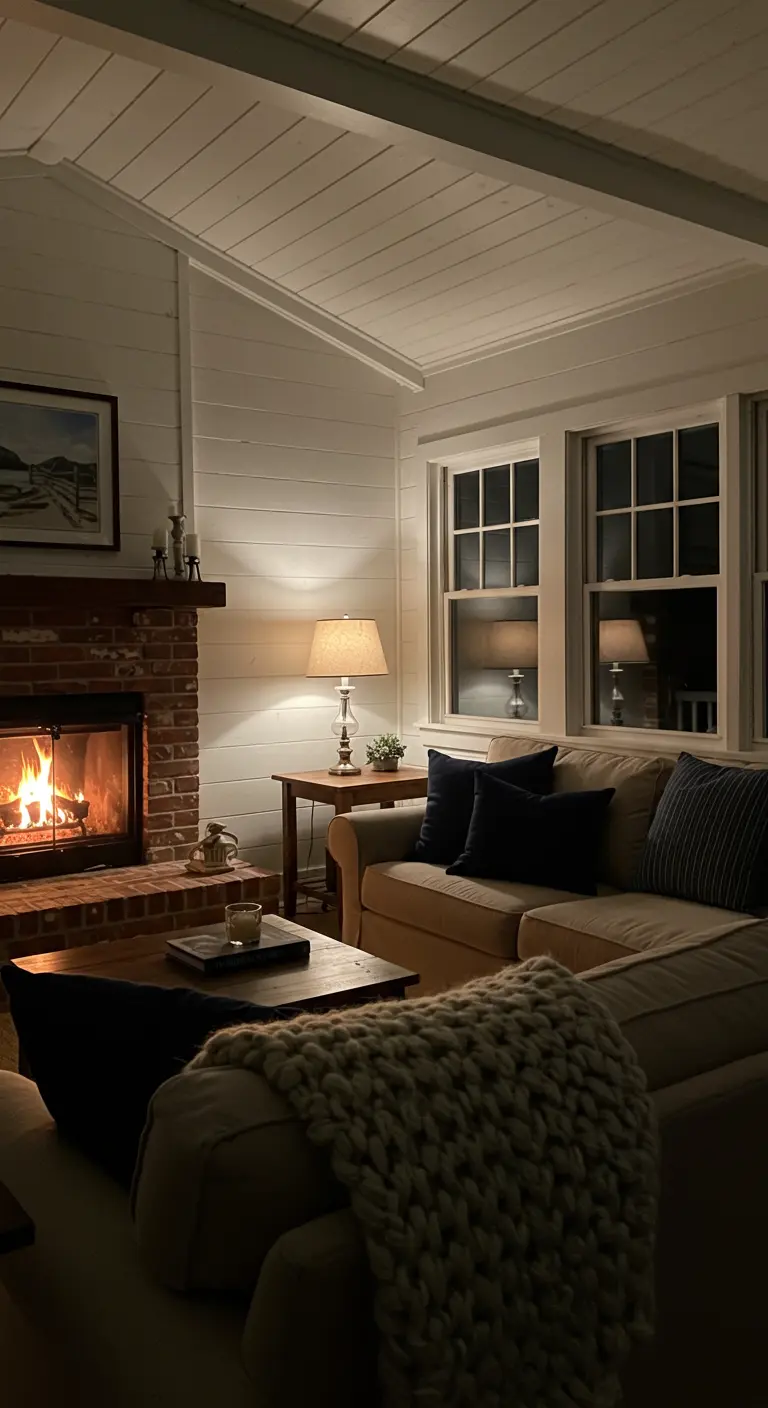
A well-designed room must feel just as inviting after dark. This is achieved through layered lighting.
Don’t rely solely on a central overhead light. Instead, create soft pools of illumination with table lamps for reading and accent lighting to highlight art.
Combined with the warm, ambient glow from a fireplace, this layered approach creates a cozy, intimate atmosphere that is impossible to achieve with a single light source.
16. Fuse Coastal with Industrial Elements
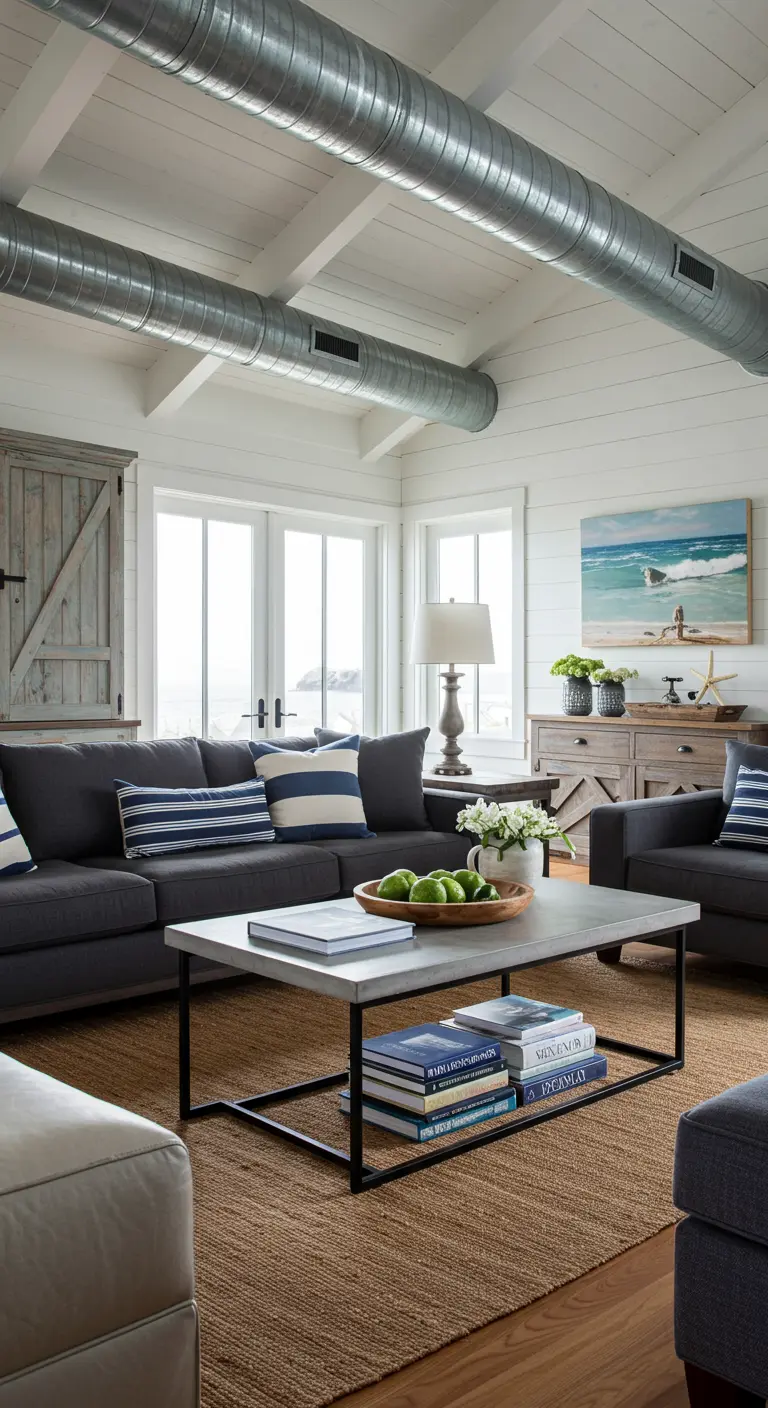
For homes with modern or industrial bones, lean into those features rather than hiding them.
The contrast between exposed metal ductwork and soft, coastal textiles creates a sophisticated, layered look. Pair the hard lines with a charcoal slipcovered sofa, classic striped pillows, and a natural fiber rug.
This thoughtful mix of styles is central to many modern farmhouse aesthetics.
17. Maximize Seating with a Conversation Pit
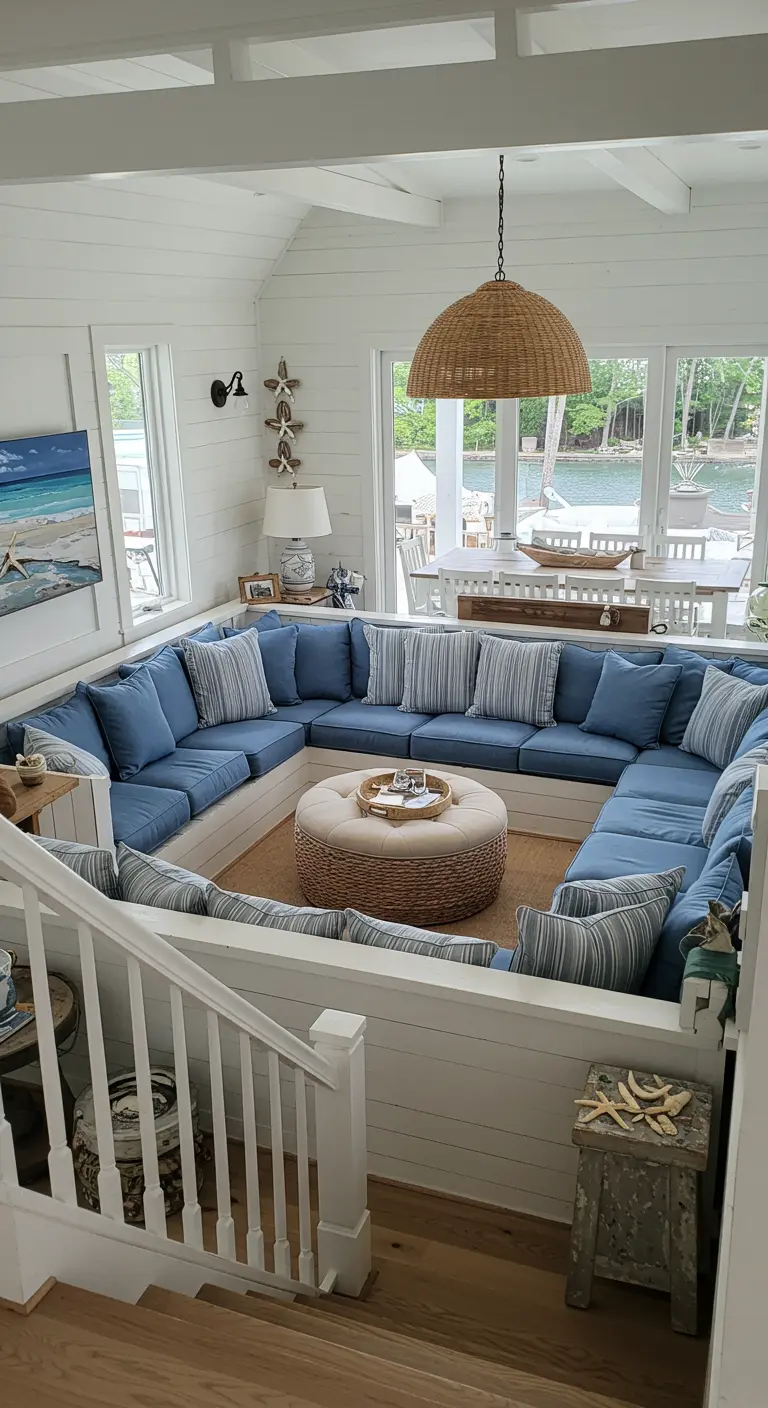
If you love to entertain and have the right architecture, a built-in U-shaped sectional or ‘conversation pit’ is the ultimate feature for communal gatherings.
It provides generous, comfortable seating and fosters an incredibly cozy and intimate atmosphere.
Keep the upholstery in a versatile neutral and load it with an array of blue solid and striped pillows to maintain the relaxed coastal theme while seating a crowd.
18. Emphasize Height with Exposed Beams

In a room with vaulted ceilings, adding or exposing natural wood beams is a transformative decision.
The beams draw the eye upward, celebrating the room’s height while adding immense architectural character and warmth.
This signature farmhouse element provides a beautiful, rustic counterpoint to the clean, crisp backdrop of white shiplap walls.
19. Vary Pillow Textures for Tactile Depth
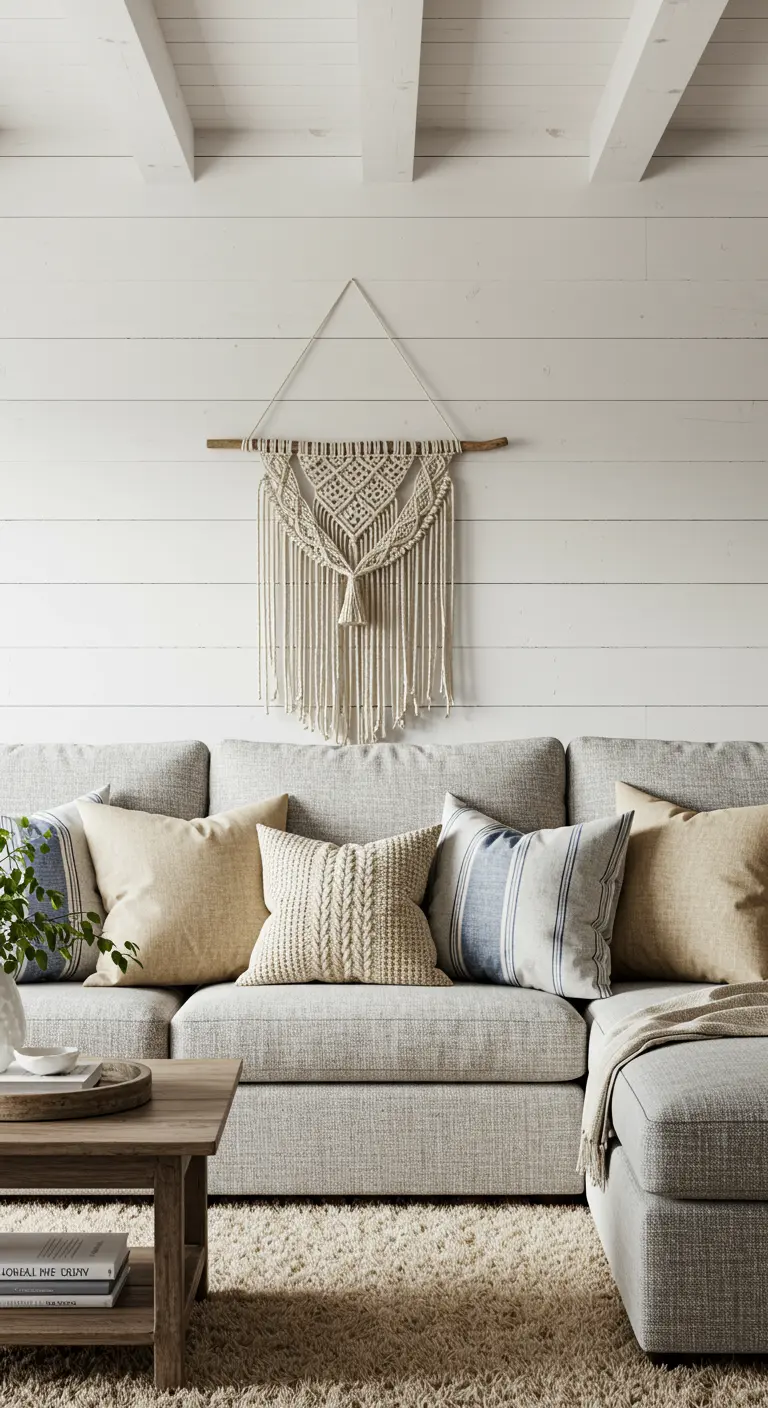
To create a truly rich and inviting sofa, think beyond color and pattern and focus on texture.
Combine pillows with different tactile qualities: a chunky cable-knit cushion, a smooth linen cover, and a classic cotton stripe.
This layering of textures creates a sophisticated, multi-dimensional look that makes your sofa feel as luxurious as it appears.
20. Introduce the Warmth of Worn Leather
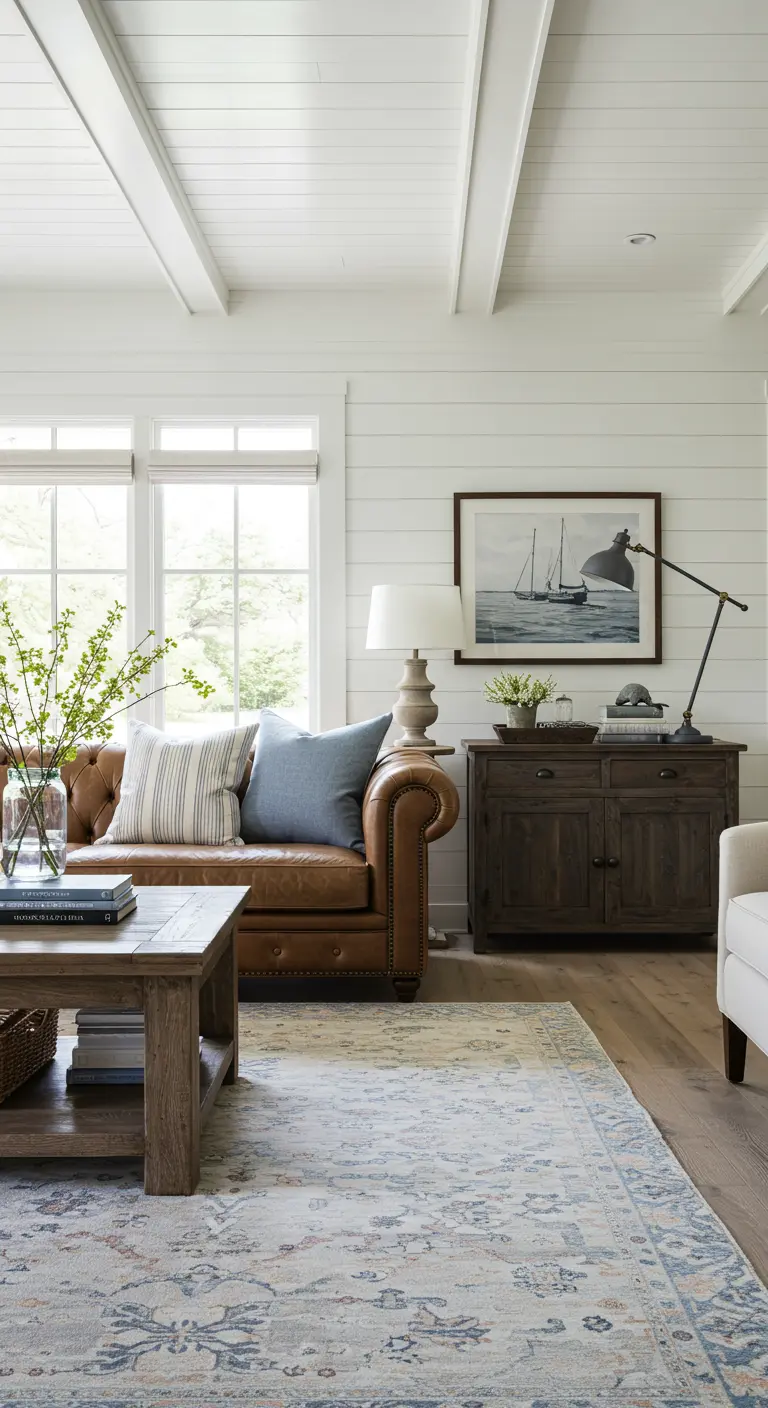
Ground an airy, light-filled room with the timeless substance of a leather sofa.
A classic Chesterfield in a rich caramel or cognac brown provides a beautiful and sophisticated contrast to white shiplap walls.
To ensure it aligns with the coastal theme, keep it from feeling too formal by styling it with a casual arrangement of breezy blue and white striped pillows.
21. Let the View Be the Ultimate Artwork

When your home is blessed with a stunning view of the water, the most important design principle is restraint.
Keep window treatments minimal or omit them entirely to create an unobstructed connection to the outdoors.
Arrange your furniture to face the vista, making the ocean the undeniable focal point. The decor in these dreamy coastal living rooms supports the view, rather than competing with it.
22. Style Your Mantel with a Color Story
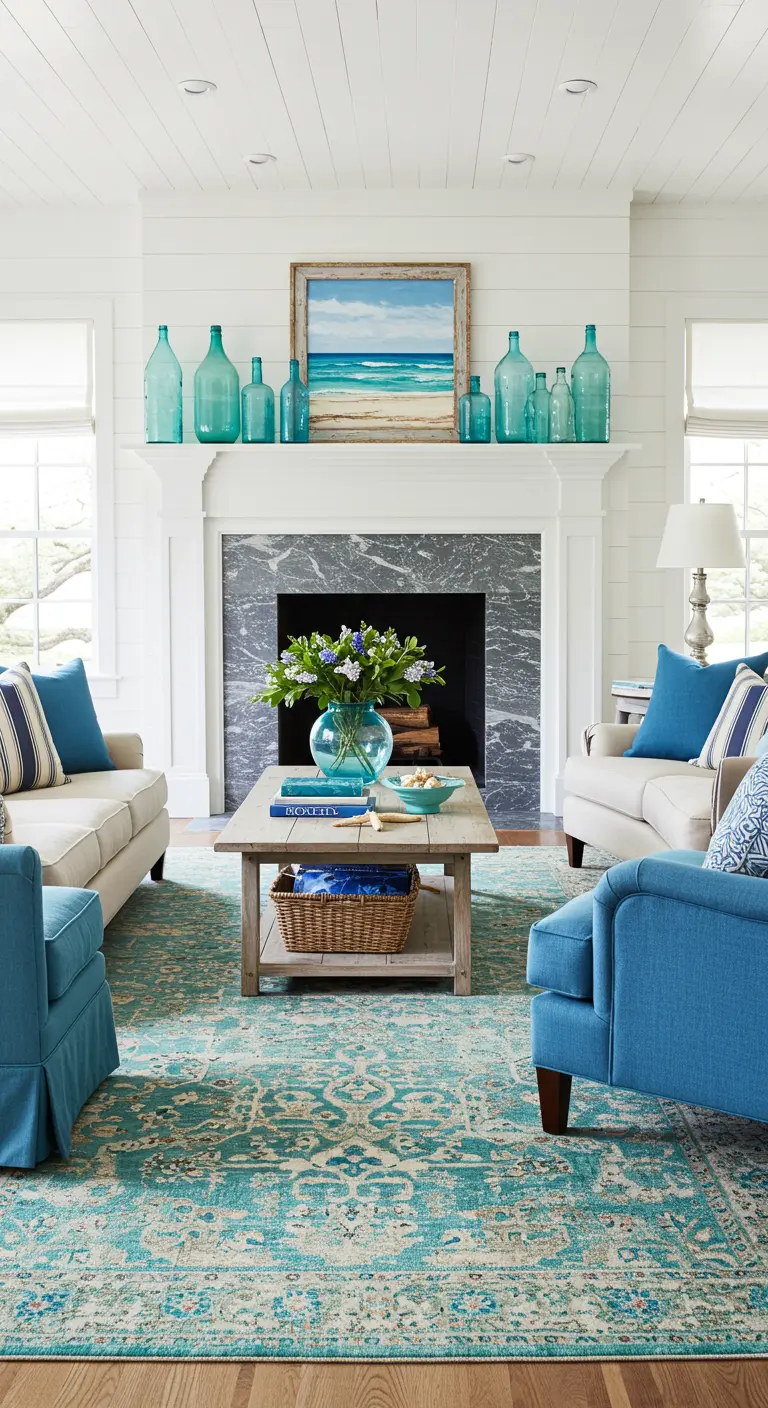
Your fireplace mantel is the perfect stage for a simple, curated display.
Create a beautiful, light-catching arrangement with a collection of glass bottles in shades of sea green and aqua.
Vary the heights and shapes of the bottles to create a dynamic silhouette, but maintain a tight, cohesive color palette. This ensures the look is curated and intentional, not random.
23. Energize with a Statement Ocean-Hued Rug
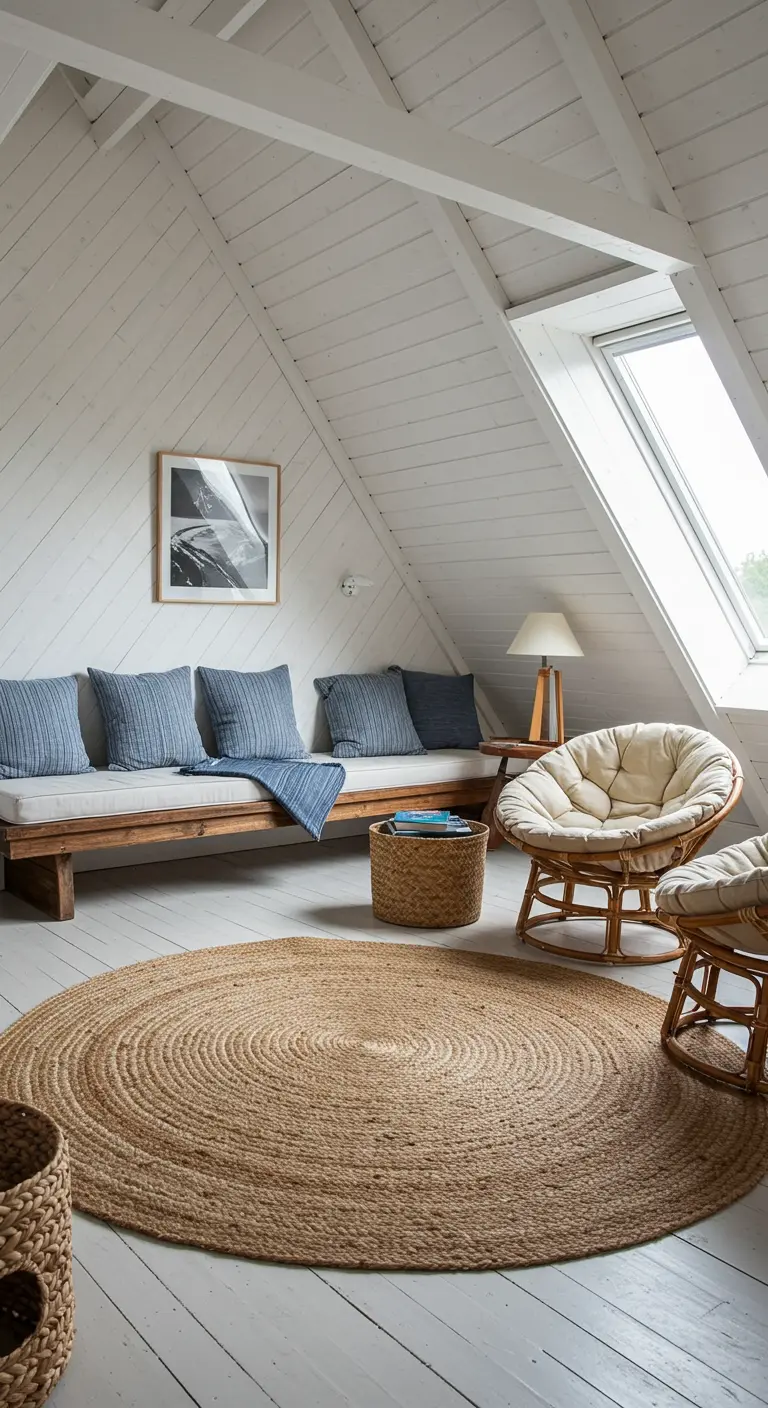
Ground your neutral sofas and chairs with a rug that commands attention.
A large, patterned area rug in vibrant shades of turquoise and teal instantly brings the colors of the ocean indoors.
It energizes the entire room and provides a clear, confident color palette to draw from for smaller accents like pillows, throws, and artwork.
24. Embrace the Angles of an Attic Space
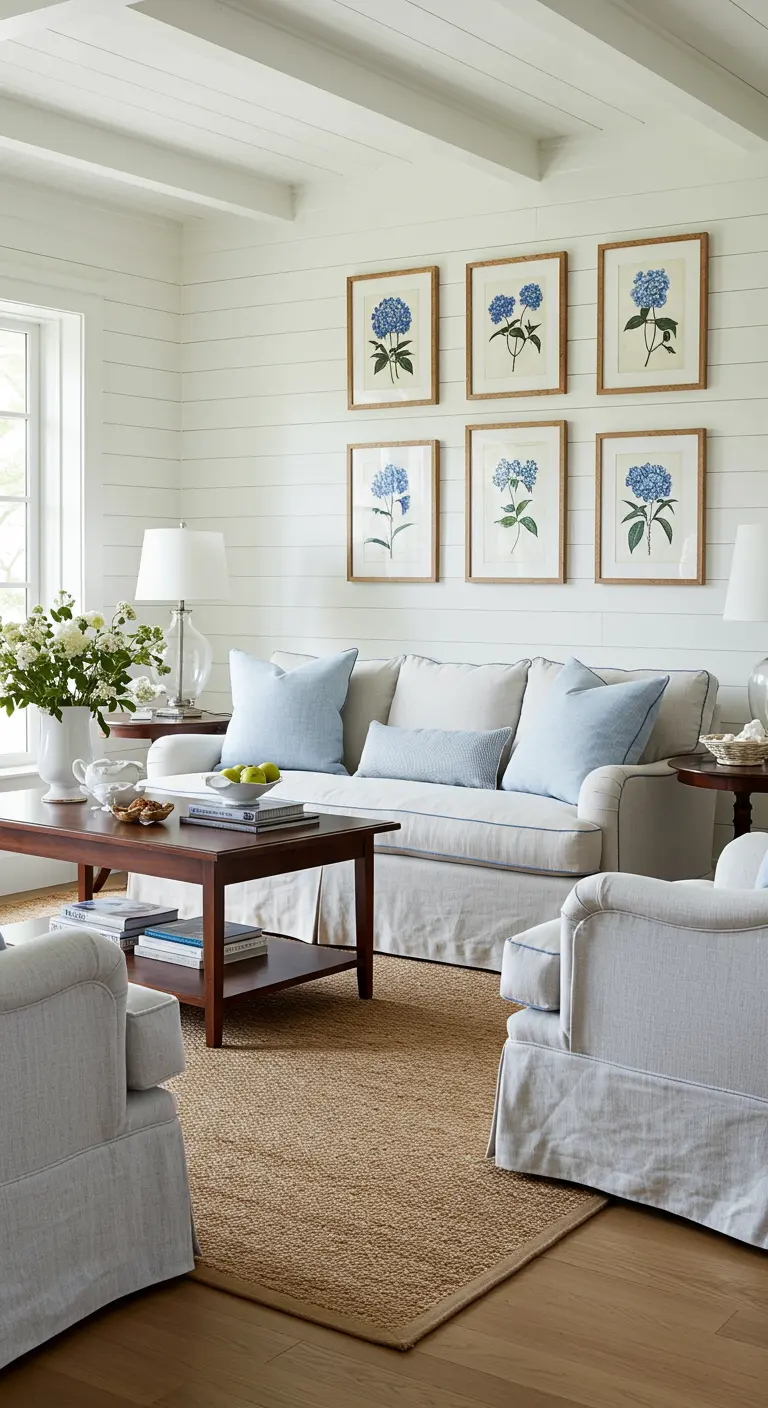
Don’t see slanted ceilings as a challenge; see them as a character-defining feature.
Paint the angled walls and ceiling in the same shade of bright white to unify the space and maximize the feeling of openness.
Use low-profile furniture, like a simple wood-frame daybed, and ground the room with a large, round jute rug to add texture and define the seating area without cluttering the unique sightlines.
25. Create a Thematic Grid Gallery Wall
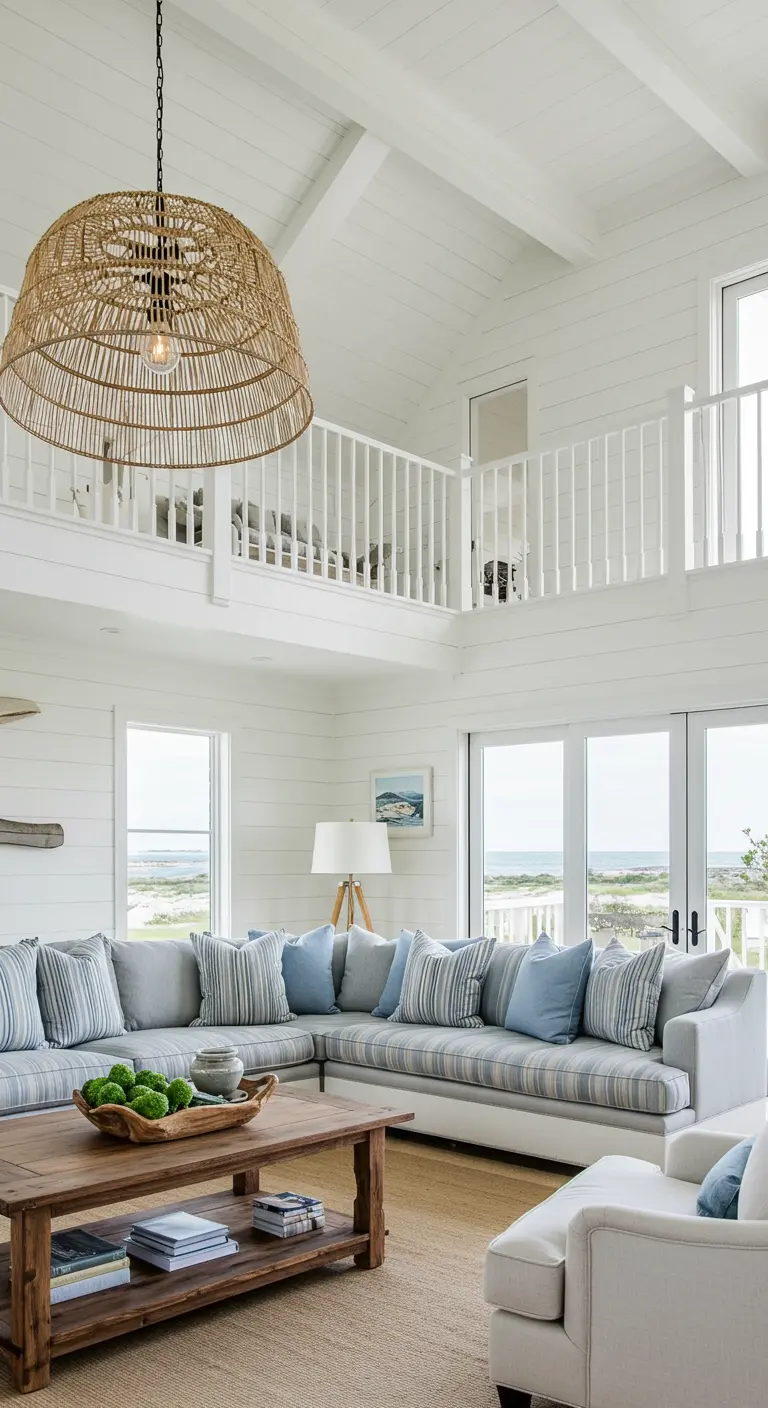
For a high-impact art installation that feels orderly and sophisticated, arrange your frames in a perfect grid.
Using identical frames and a consistent theme—like these beautiful blue hydrangea botanical prints—creates a powerful visual statement.
This approach feels more deliberate and polished than a randomly assorted gallery wall and perfectly complements the clean lines of the shiplap.
26. Define a Zone with a Statement Pendant
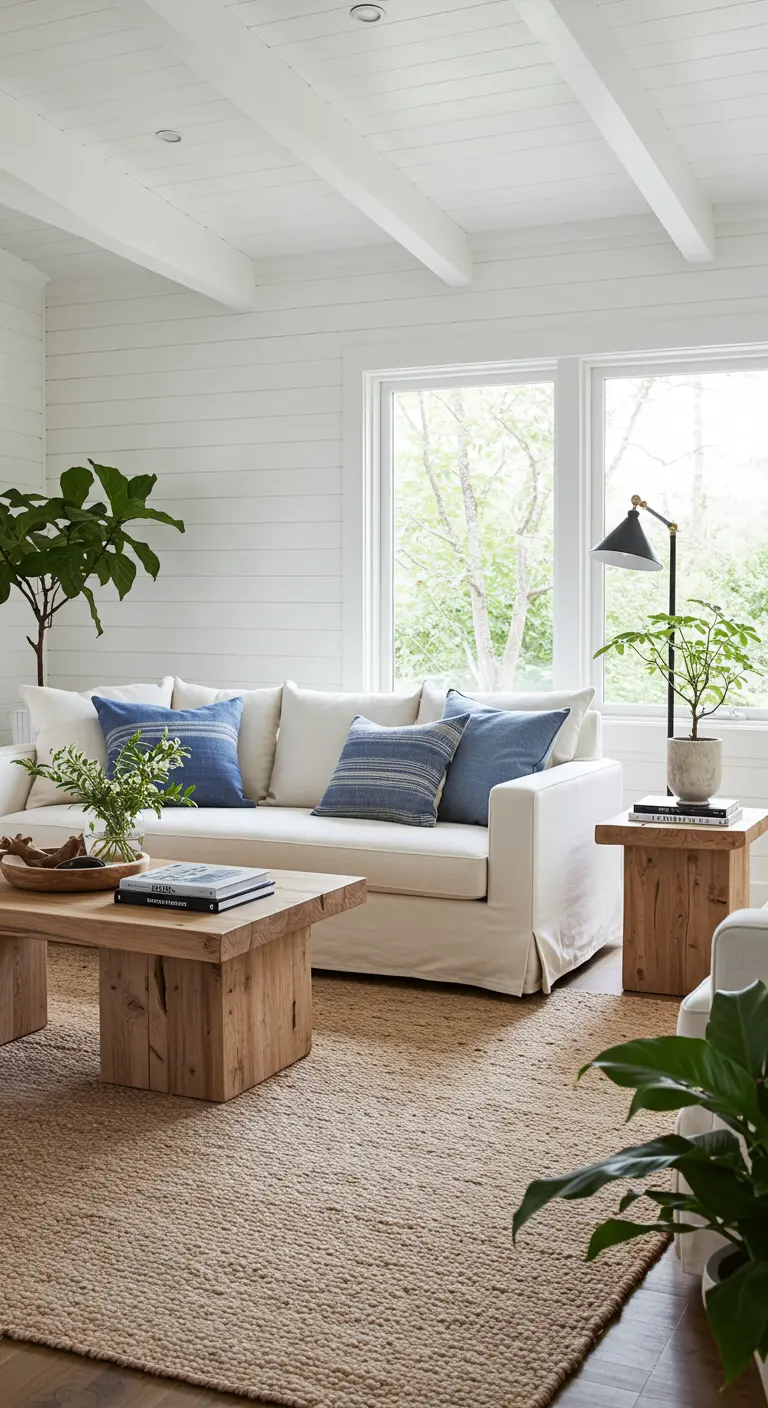
In a large, open-concept room or one with double-height ceilings, a large-scale light fixture is essential for creating intimacy.
Hang an oversized woven rattan pendant light directly over your main seating area. It acts as a visual anchor, defining the zone and making it feel cozier.
The natural texture also adds warmth and a relaxed, bohemian touch to the coastal aesthetic.
27. Layer in Greenery and Raw Wood

Deepen the connection to nature in your coastal home by incorporating plenty of houseplants.
Pair the living greenery with furniture made from raw, chunky wood, like solid block coffee and side tables. The combination of live plants and rustic wood enhances the organic, calming atmosphere of the space.
This strategy is key to creating nature-inspired small spaces that feel restorative.
28. Add Winter Warmth without Losing the Style
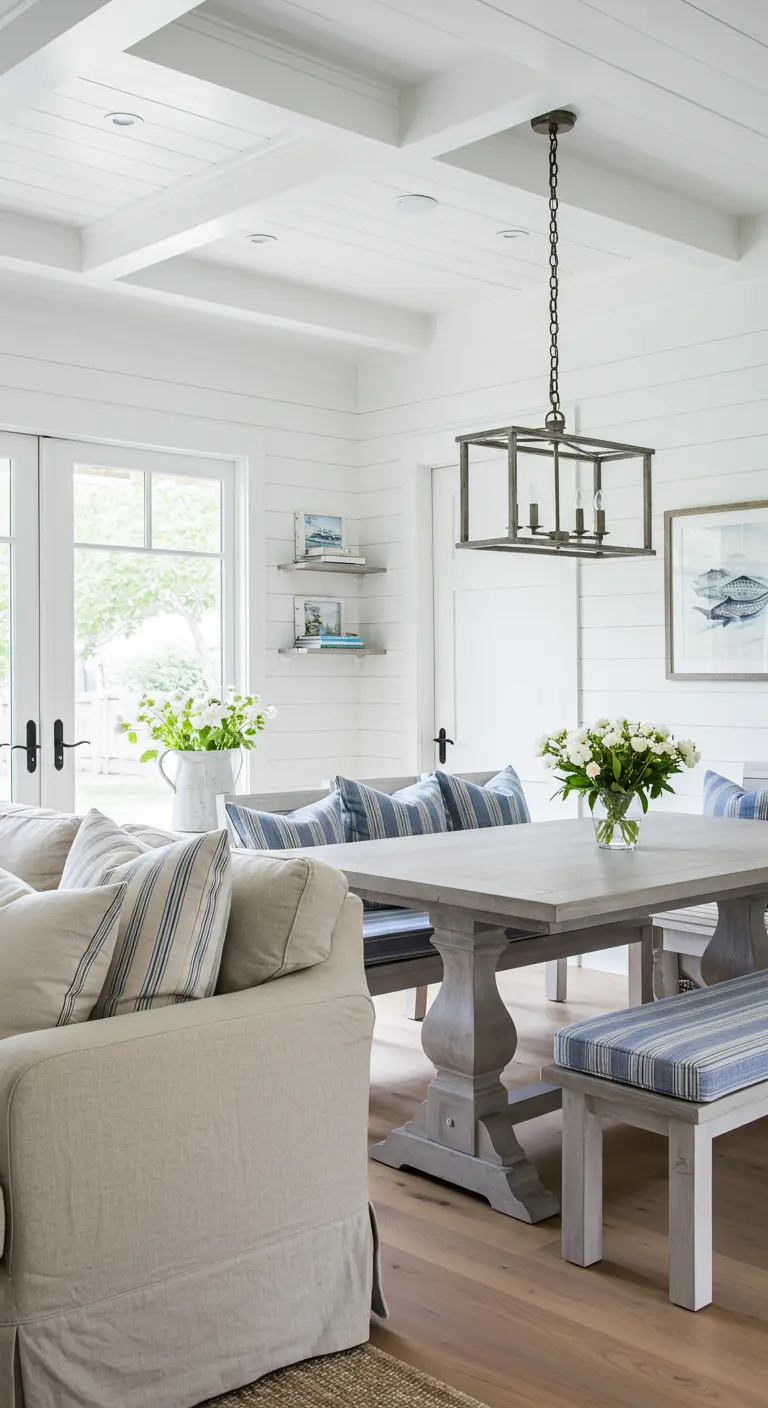
Your coastal living room can feel just as inviting in the colder months with a few simple adjustments.
Drape a luxuriously soft faux-fur throw over the arm of your sofa for instant textural warmth.
Keep firewood for the hearth neatly contained in stylish woven baskets. These simple additions add a cozy, seasonal layer without compromising the light and airy coastal farmhouse aesthetic.
29. Unify Living and Dining with a Cohesive Palette
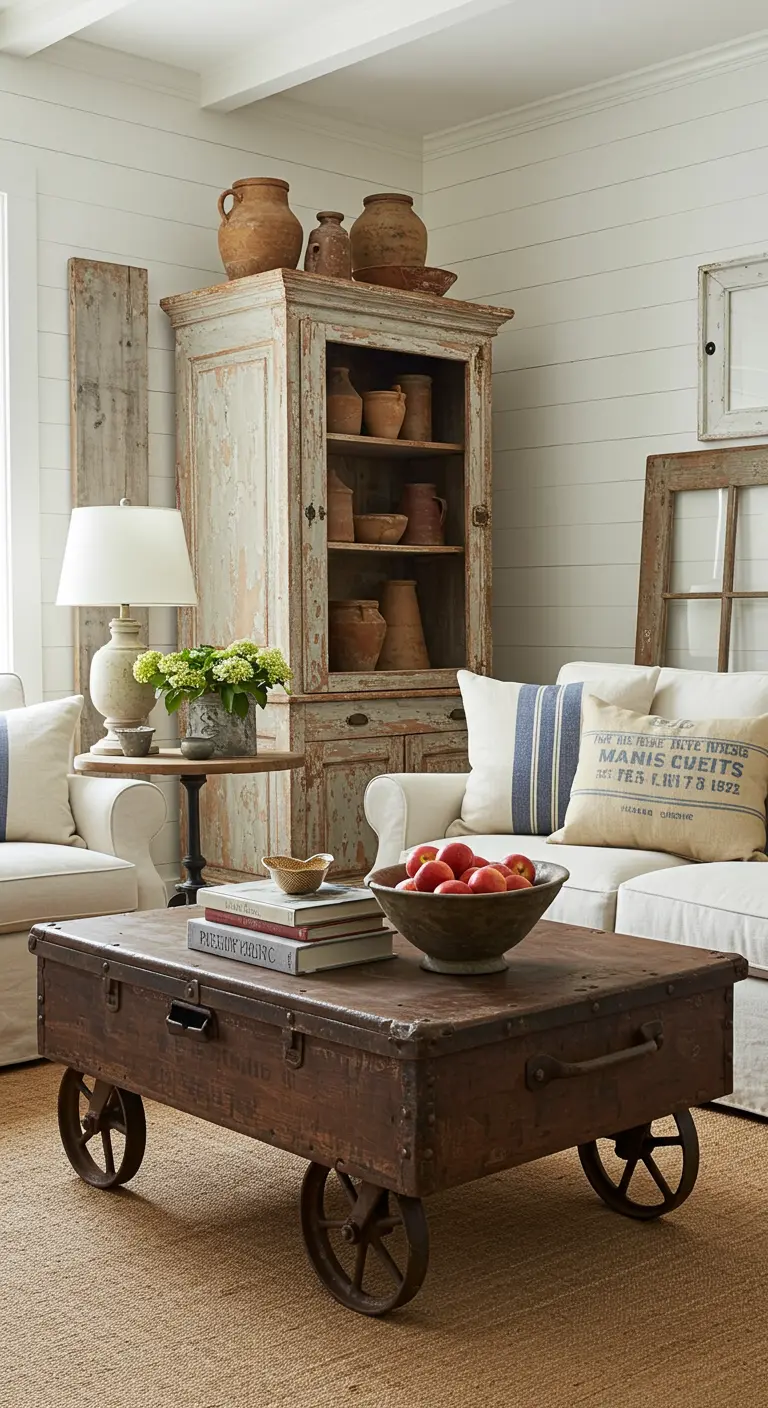
In an open-plan room, create a seamless flow between the living and dining zones.
Behind the main seating area, place a rustic trestle table with simple cushioned benches. This banquette style of seating feels casual and communal.
By using the same blue and white striped fabric on the bench cushions as on the sofa’s throw pillows, you visually link the two areas, making the entire space feel cohesive and thoughtfully designed.
30. Blend Farmhouse Charm with Industrial Relics
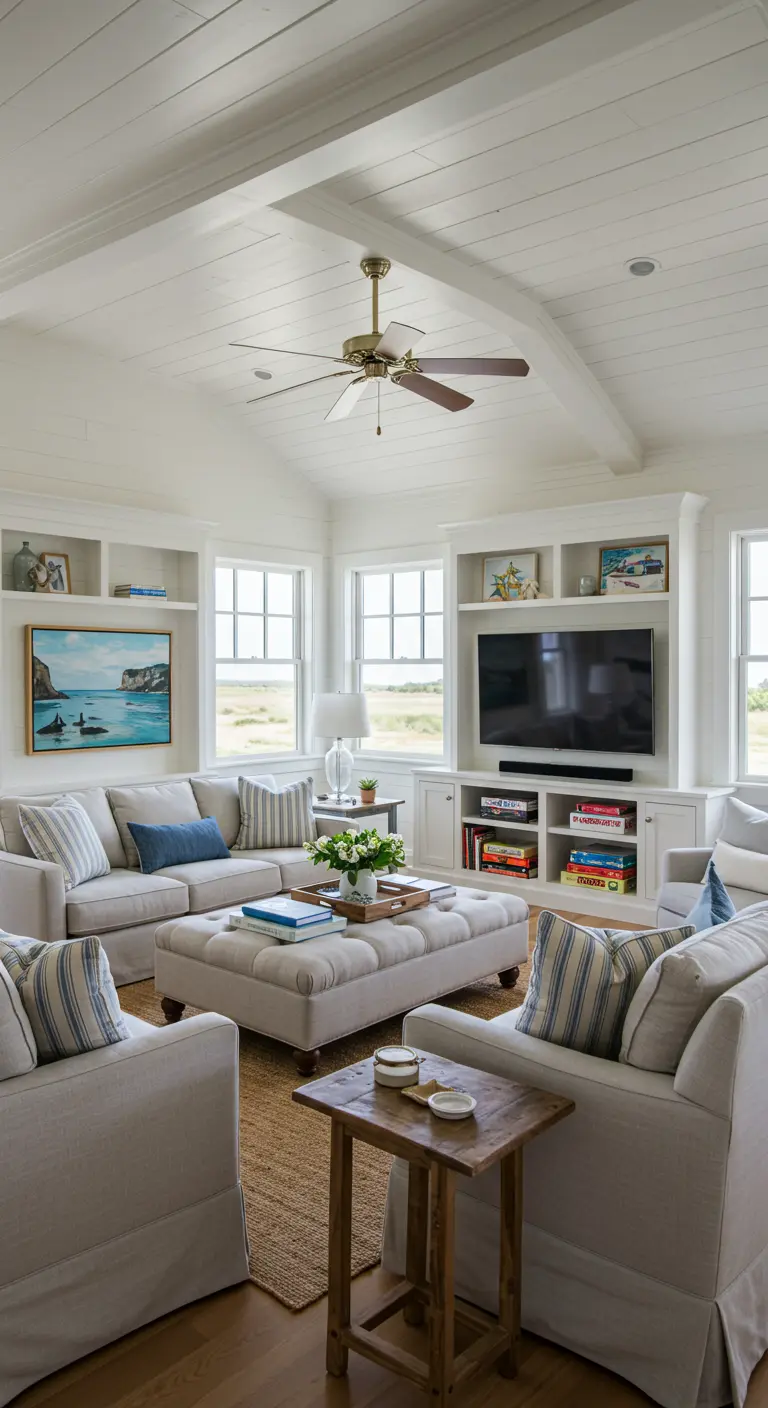
The most compelling interiors often arise from a confident mix of styles.
Pair a classic farmhouse piece, like a tall hutch with a distressed painted finish, with an unexpected industrial element, like a factory cart repurposed as a coffee table.
This farmhouse industrial fusion creates a dynamic tension between rustic charm and raw utility, resulting in a space with unique character and depth.
